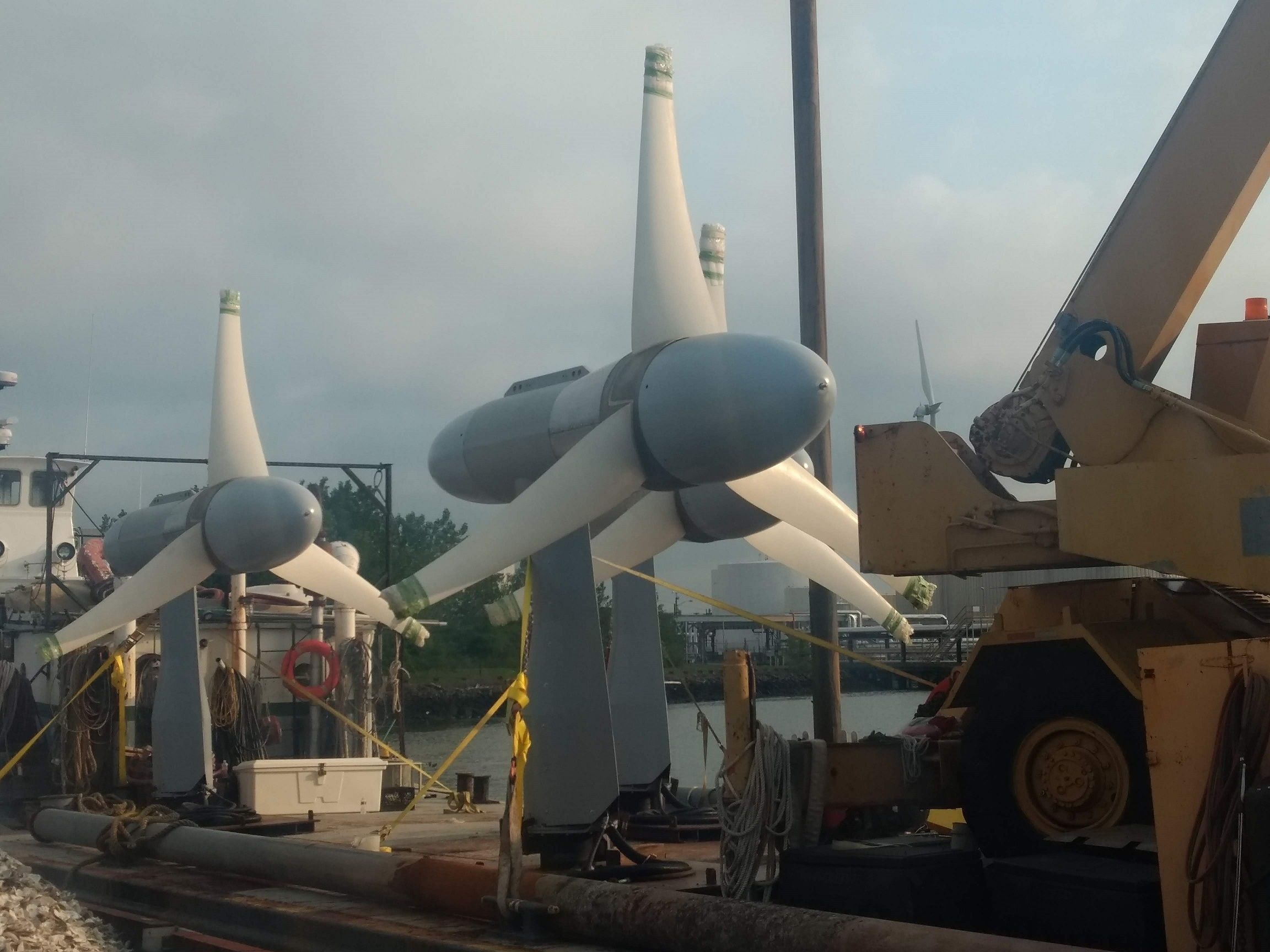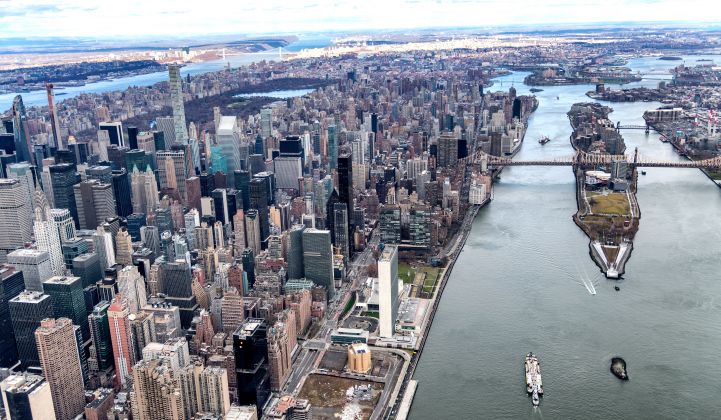New York City is close to seeing tidal power injected onto its local grid.
Verdant Power, a 20-year-old tidal energy startup, is currently installing a half-scale generator in the East River tidal strait. Installation may be finished a few days from now, said Trey Taylor, the company's co-founder and chief commercial officer.
The Roosevelt Island Tidal Energy (RITE) installation will feature three underwater 35-kilowatt turbines on a single triangular base called a TriFrame. The project will add a small but novel source of generation for a city hungry for renewable energy but with limited means to generate it locally.
The RITE project may have bigger implications than the Big Apple's renewables goals.
If the RITE generator is successful, Verdant hopes to get its technology certified by the European Marine Energy Centre, the world’s leading tidal testing facility. Subject to certification, the startup then plans to deploy two full-size arrays, equipped with 10-meter-diameter blades instead of the current 5-meter models, off the coast of Wales, U.K., by sometime in 2023, in what it hopes will be the first step in the development of a 30-megawatt tidal farm.

Verdant Power's fifth-gen turbines before attachment to the TriFrame base. (Photo: Verdant Power)
Back in New York, Verdant hopes the RITE project could form the basis for a half-scale tidal demonstration center in the East River. For nearly a decade, the New York-based startup has held a Federal Energy Regulatory Commission license to install up to a megawatt of tidal power in New York City, enough for thirty of its 35 kW turbines mounted on ten TriFrames.
Still, the path toward bigger tidal arrays, and even more demonstration projects, looks challenging.
Deployment of the full-scale machines at the West Anglesey Tidal Demonstration Zone in Wales is dependent on finding revenue support, Trey Taylor, Verdant co-founder and chief commercial officer, said in an interview. Plans for the larger demonstration center in the East River would also require funding.
Tidal sector slow to take off
Verdant's grand plans for deployment and the attendant caveats will have a familiar ring to those who have watched the tidal stream energy sector struggle to live up to its promises over the last two decades.
Verdant Power itself is a prime example of the sluggish pace at which the technology is progressing in the fast-moving world of renewable energy. Verdant first started testing a prototype of its turbine, which it refers to as a free-flow kinetic hydropower system, in 2002. It was awarded the federal license for RITE in 2012.
In 2014, GTM reported that the company still had not deployed its turbines, despite receiving $30 million over 14 years and attracting significant media coverage of its New York City plans. Verdant secured a further $6 million from backers including the U.S. Department of Energy and the New York State Energy Research and Development Authority (NYSERDA) in late 2018, putting wind in the sails of the RITE array.
In this month's interview, Taylor downplayed the significance of the company’s long road to commercialization. “There really hasn’t been a problem other than money,” he said. “And money isn’t the only answer.
“Both the Electric Power Research Institute and the Sustainable Energy Authority of Ireland say that on average it takes 10 to 12 years to bring a working prototype to commercialization,” Taylor added.
Verdant Power’s technology dates back to the late 1980s, when New York University scientist Dean Corren, now the company’s chief technology officer, tested an early version in Pakistan with support from a United Nations renewable energy program. The DOE advocated commercializing the technology in 1995, leading to the incorporation of Verdant Power and testing of a third-generation prototype beginning in 2003.
“That was really a proof of concept at that time,” Taylor explained.
In 2006, Verdant Power claimed to be the first company in the world to connect a tidal turbine array to the grid. It mounted six fourth-generation turbines on monopiles for a couple of years in New York's East River, carrying out environmental testing and improving the spacing of machines in the array.
The time since has been mostly about progressing the turbine design through various technology readiness levels, Taylor said.
Verdant Power believes its current half-size, fifth-generation model is almost at a technology readiness level of 9, which equates to "proven in an operational environment." The period of “2007 to 2019 was our 12 years,” said Taylor.
Not looking to compete with wind and solar
The major challenge for Verdant, and indeed all other next-generation renewable energy technology developers, is that even if it can fully commercialize its machines in the next couple of years it will be hard-pressed to compete against wind and solar.
Taylor said Verdant Power is targeting a levelized cost of energy of $140 per megawatt-hour and an installed cost of $3 million per megawatt once it achieves around 400 MW of installed capacity, falling to $100 per megawatt-hour and $2.2 million per megawatt at 2 gigawatts.
But the tidal energy sector is years away from reaching 2 GW of installed capacity, if it ever manages to get there. And even then, Verdant's projected costs are still far above the levelized costs of wind and solar, which last year were down to $26 and $29 per megawatt-hour, respectively, according to Lazard.
Verdant is not intending to compete with mainstream wind and solar, Taylor said. Instead, the company's focus will be on markets with revenue support or existing high energy prices.
“Amazonia has over 2,000 diesel[-powered] villages,” he said. “The Philippines has over 6,000 islands.”
For now, the company’s federal and state backers are sticking by the business model.
“As part of New York’s nation-leading efforts to achieve Governor Cuomo’s goals to obtain 70 percent of its electricity from renewable sources by 2030 and 100 percent from clean sources by 2040, the state is assessing all opportunities,” a NYSERDA spokesperson said in an email.




